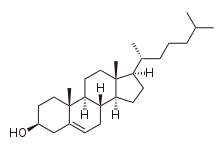Triterpene
Triterpenesare a class ofterpenescomposed of sixisopreneunits with the molecular formula C30H48;they may also be thought of as consisting of threeterpeneunits. Animals, plants and fungi all produce triterpenes, includingsqualene,the precursor to allsteroids.[1][2]
Structures[edit]
Triterpenes exist in a great variety of structures. Nearly 200 different skeletons have been identified.[3]These skeletons may be broadly divided according to the number of rings present. In general pentacyclic structures (5 rings) tend to dominate.
| Number of rings | Examples |
|---|---|
| 0 | Squalene |
| 1 | Achilleol A[4] |
| 2 | Polypodatetraene |
| 3 | Malabaricane |
| 4 | Lanostane,Cucurbitacin |
| 5 | Hopane,Oleanane,Ursolic acid |
| 6 | Chamaecydin |
Squaleneis biosynthesized through the head-to-head condensation of twofarnesyl pyrophosphateunits. This coupling converts a pair of C15 components into a C30 product. Squalene serves as precursor for the formation of many triterpenoids, including bacterialhopanoidsand eukaryoticsterols.
Triterpenoids[edit]

By definition triterpenoids are triterpenes that possessheteroatoms,usually oxygen. The termstriterpeneandtriterpenoidoften are used interchangeably.
Triterpenoids possess a rich chemistry and pharmacology (e.g.cholesterol) with several pentacyclic motifs.Lupane,oleananeandursaneshow particular promise as anti-cancer agents.[5][6]
Steroids[edit]
Steroids feature acucurbitanecore, although in practice they are biosynthesised from eitherlanosterol(animals and fungi) orcycloartenol(plants) via the cyclization ofsqualene.Steroids have two principal biological functions, being either key components of cell membranes or signaling molecules that activatesteroid hormone receptors.Important sub-classes includesterolsandcucurbitacins.
Triterpenoid saponins[edit]
Triterpenoid saponinsare triterpenes which belong to thesaponingroup of compounds, making them triterpenoidglycosides.They are produced by plants as part of their self-defense mechanism[7]with important sub-classes includingginsenosides[8]andeleutherosides.
References[edit]
- ^Eberhard Breitmaier (2006). "Triterpenes".Terpenes: Flavors, Fragrances, Pharmaca, Pheromones.pp. 86–108.doi:10.1002/9783527609949.ch6.ISBN9783527609949.
- ^Davis, Edward M.; Croteau, Rodney (2000). "Cyclization Enzymes in the Biosynthesis of Monoterpenes, Sesquiterpenes, and Diterpenes".Topics in Current Chemistry.209:53–95.doi:10.1007/3-540-48146-X_2.ISBN978-3-540-66573-1.
- ^Xu, Ran; Fazio, Gia C.; Matsuda, Seiichi P.T. (February 2004). "On the origins of triterpenoid skeletal diversity".Phytochemistry.65(3): 261–291.doi:10.1016/j.phytochem.2003.11.014.PMID14751299.
- ^Barrero, A.F.; Alvarez-Manzaneda, E.J.R.; Alvarez-Manzaneda r, R. (1989-01-01)."Achilleol A: A new monocyclic triterpene skeleton from Achillea odorata L."Tetrahedron Letters.30(25): 3351–3352.doi:10.1016/S0040-4039(00)99242-6.ISSN0040-4039.
- ^Laszczyk, Melanie (2009)."Pentacyclic Triterpenes of the Lupane, Oleanane and Ursane Group as Tools in Cancer Therapy".Planta Medica.75(15): 1549–60.doi:10.1055/s-0029-1186102.PMID19742422.
- ^Liu, Jie (December 1995). "Pharmacology of oleanolic acid and ursolic acid".Journal of Ethnopharmacology.49(2): 57–68.doi:10.1016/0378-8741(95)90032-2.PMID8847885.
- ^Augustin, Jörg M.; Kuzina, Vera; Andersen, Sven B.; Bak, Søren (April 2011). "Molecular activities, biosynthesis and evolution of triterpenoid saponins".Phytochemistry.72(6): 435–457.doi:10.1016/j.phytochem.2011.01.015.PMID21333312.
- ^Attele, Anoja S; Wu, Ji An; Yuan, Chun-Su (December 1999). "Ginseng pharmacology".Biochemical Pharmacology.58(11): 1685–1693.doi:10.1016/S0006-2952(99)00212-9.PMID10571242.

